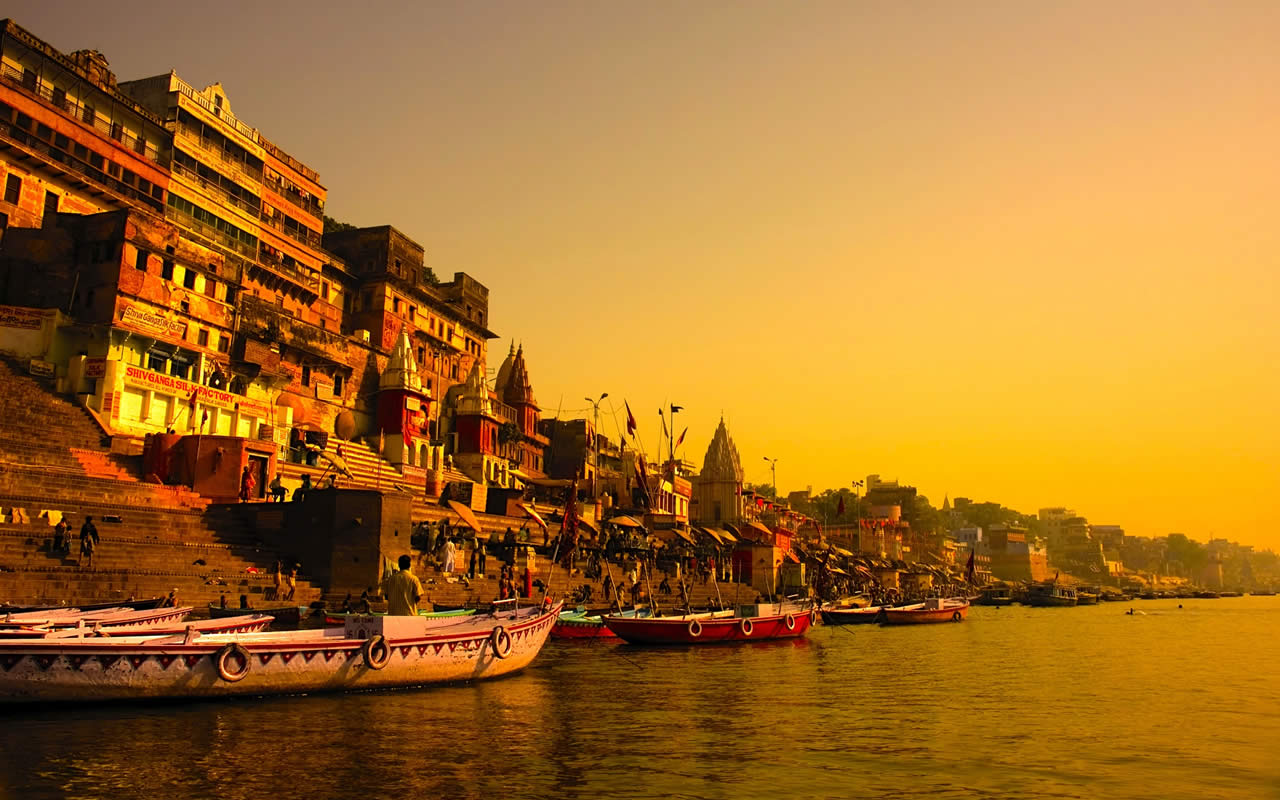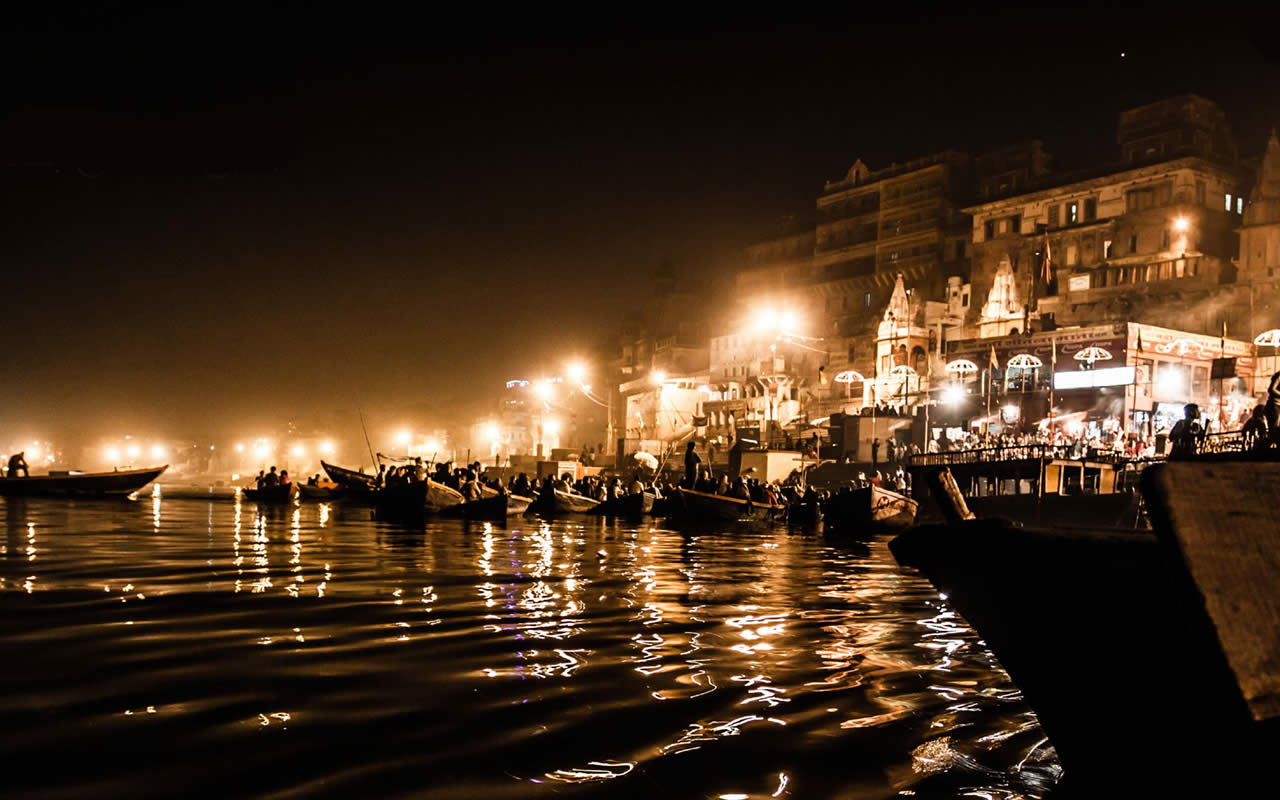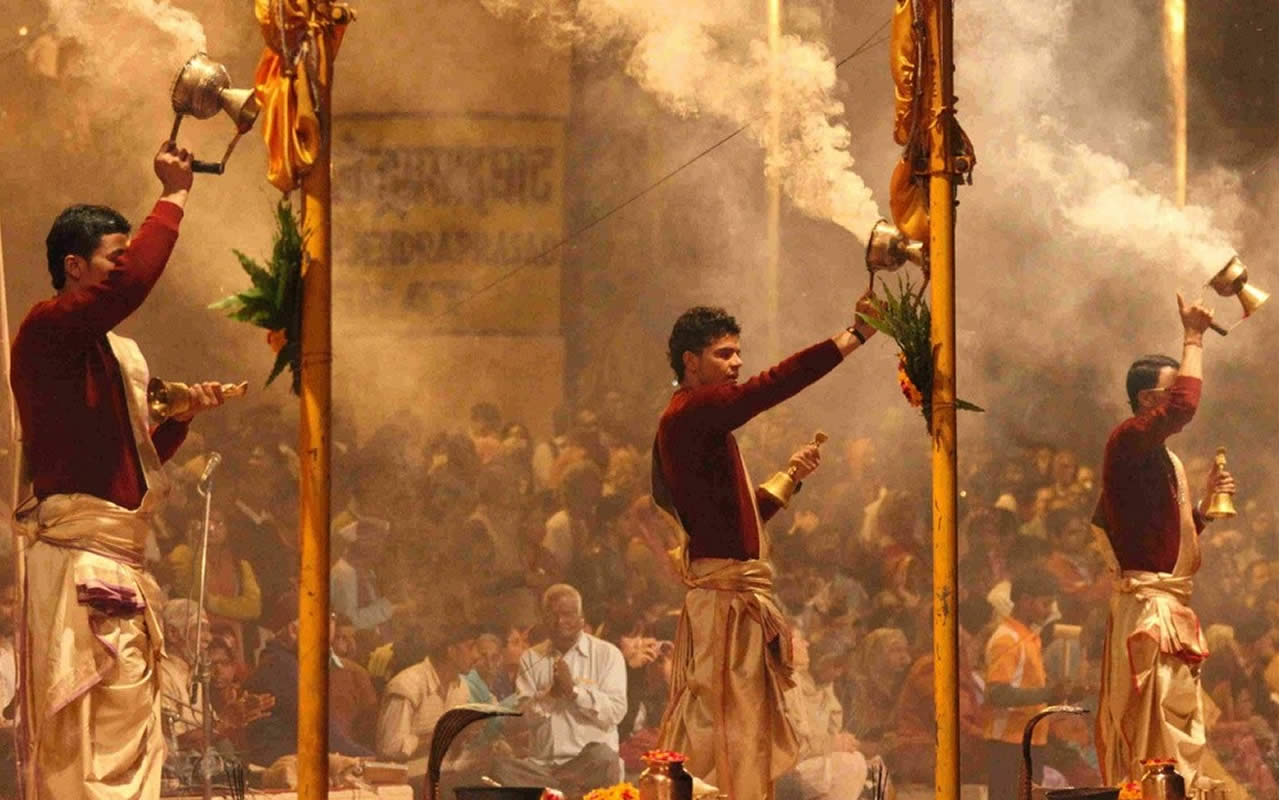Varansi
City of Gods
Highlights : Boat Rides on The Ganges, Ganga Aarti, Spirituality, Sarnath
Varanasi , also known as Benares, Banaras , is a North Indian city on the banks of the Ganges in Uttar Pradesh, India 320 kilometres (200 mi) south-east of the state capital, Lucknow and 121 kilometres (75 mi) east of Allahabad. Varanasi is one of the oldest continuously inhabited cities in the world. The spiritual capital of India, it is the holiest of the seven sacred cities (Sapta Puri) in Hinduism and Jainism, and played an important role in the development of Buddhism. Varanasi lies along National Highway 2, which connects it to Kolkata, Kanpur, Agra, and Delhi, and is served by Varanasi Junction and Lal Bahadur Shastri International Airport.
Varanasi grew as an important industrial centre, famous for its muslin and silk fabrics, perfumes, ivory works, and sculpture. Buddha is believed to have founded Buddhism here around 528 BC when he gave his first sermon, “The Setting in Motion of the Wheel of Dharma”, at nearby Sarnath. The city’s religious importance continued to grow in the 8th century, when Adi Shankara established the worship of Shiva as an official sect of Varanasi. Despite the Muslim rule, Varanasi remained the centre of activity for Hindu intellectuals and theologians during the Middle Ages, which further contributed to its reputation as a cultural centre of religion and education. Several major figures of the Bhakti movement were born in Varanasi, including Kabir and Ravidas. Guru Nanak Dev visited Varanasi for Shivratri in 1507, a trip that played a large role in the founding of Sikhism. In the 16th century, Varanasi experienced a cultural revival under the Muslim Mughal emperor Akbar who invested in the city, and built two large temples dedicated to Shiva and Vishnu, though much of modern Varanasi was built during the 18th century, by the Maratha and Bhumihar kings. The kingdom of Benares was given official status by the Mughals in 1737, and continued as a dynasty-governed area until Indian independence in 1947. The city is governed by the Varanasi Nagar Nigam (Municipal Corporation) and is represented in the Parliament of India by the current Prime Minister of India Narendra Modi, who won the Lok Sabha elections in 2014 by a huge margin. Silk weaving, carpets and crafts and tourism employ a significant number of the local population, as do the Diesel Locomotive Works and Bharat Heavy Electricals Limited. Varanasi Hospital was established in 1964.
Varansi By Road
The Uttar Pradesh State Buses as well as the private bus services makes it possible for all to access the city with ease and at a reasonable cost. It solves the query of many who are worried about how to reach Varanasi by road. There are frequent buses from Varanasi to the Allahabad (120 km), Gorakhpur (165 km), Patna (215 km), Lucknow (270 km) and Ranchi (325 km) from Varanasi.
Varansi By Rail
The city is well connected by rail and hence it solves the issue of how to reach Varanasi. The city mainly has two major railway stations that connect it to all the major cities and towns of the country. Varanasi railway station and Kashi railway station, these two are the main railheads which make it possible for all to reach the city with ease.
Varansi By Air
Varanasi airport is well connected with all the major cities of the country. One does not need to worry how to reach Varanasi by air as it has very good connectivity. Get easy flights from Delhi to Varanasi, Flights from Mumbai to Varanasi and other cities.
Nearest Airport : Lal Bahadur Shastri Airport, Varanasi
Bharat Mata Temple
A temple without any idol? Surprising, but true! The Bharat Mata Temple is a unique amalgamation of patriotism and spiritualism. Located in Varanasi, the temple is a grand display of Mother India but not in the form of any deity or Goddess but as a marble-carved relief map that amazingly pin-points the geographical beauty of undivided India. The temple was built by Babu Shiv Prasad Gupt and Durga Prasad Khatri and was inaugurated by Mahatma Gandhi in 1936.
The map is an intricately-carved marble work with immense expertise and subtlety involved in bringing-out the beauty of rivers, mountains, plains, oceans and landscapes, giving it a near-real feel. It is housed in a pentagonal-shaped temple that stands on 5 distinct pillars, depicting the basic elements of nature, that converge at the top, symbolising Supreme Power. This one-of-a-kind construction draws-in a huge crowd who marvel at the brilliance of the inimitable craftsmanship.
Pointers that would help you chalk a hassle-free plan are:
It remains opened 7-days a week.
Visiting hours: 6:00am to 12:00pm and 1:00pm to 7:00pm
An hour would be good enough to explore the place.
It is housed within the premises of Mahatma Gandhi Kashi Vidyapeeth Institute.Dhamek Stupa
Sarnath
It is one of the ultimate places to visit in Sarnath. The lower part of the Stupa is made up of stone and is noticeable for its delicate floral carvings. It is made of brick and stone during the Maurya Dynasty. The Stupa is 44 m in height and 28 m in diameter.Vishwanath Temple
There are temples at almost every turn in Varanasi, but this is the most famous of the lot. It is dedicated to Vishveswara – Shiva as lord of the universe. The current temple was built in 1776 by Ahalya Bai of Indore; the 800kg of gold plating on the tower and dome was supplied by Maharaja Ranjit Singh of Lahore 50 years later.
The area is full of soldiers because of security issues and communal tensions. Bags, cameras, mobile phones, pens or any other electronic device must be deposited in lockers (₹20) before you enter the alleyway it’s in. Accounts vary as to whether or not foreigners can go in the temple itself. Officially, non-Hindus, which counts most foreigners, cannot enter the temple, but many expats living in Varanasi as well as travelers have reported they were allowed in. We get the impression it's up to the whim of the security guards that day. For what's it's worth, they would not let us in until we returned with a local handler to sort things out. Declaring an interested or curiosity in Hindu beliefs may help you gain access (and it helps if you have an offering in hand, which can be purchased inside or outside the temple). Either way, bring your original passport (not a copy) if you want to enter. Once inside, it's quite a show, with people pushing, tripping over and sometimes violently asserting themselves for a chance to give an offering and touch the lingam, which resolves one of all sins. Hindus routinely wait in lines for 48 hours to enter on particularly holy days.
Dashashwamedh Ghat
Varanasi’s liveliest and most colourful ghat is Dashashwamedh Ghat, easily reached at the end of the main road from Godaulia Crossing . The name indicates that Brahma sacrificed (medh) 10 (das) horses (aswa) here. In spite of the oppressive boat owners, flower sellers and touts trying to drag you off to a silk shop, it’s a wonderful place to linger and people-watch while soaking up the atmosphere.
Every evening at 7pm an elaborate ganga aarti ceremony with puja, fire and dance is staged here.












